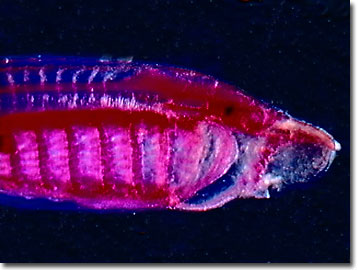Darkfield Digital Image Gallery
Lamprey Larva (Ammocoetes)
The larval stage of the primitive lamprey, known as an ammocoetes larva, serves to illustrate the much-maligned concept of ontogeny recapitulating phylogeny by resembling the more primitive chordate, Amphioxus, in morphology and behavior. The ammocoetes displays many characteristics of ancient chordates, and shared embryological traits of the vertebrates including gill slits, a notochord, myomeres (body muscle segments), a dorsal nerve cord, a dorsal fin, and a primitive nervous system with a brain and eyes. Originally described in Europe, Ammocoetes was at first incorrectly believed to be a separate genus of the Cyclostomata (lampreys and hagfish).

As a filter feeder on drifting plankton and detritus, the ammocoetes has an enlarged pharynx that operates with the seven pairs of gill slits. In the larval lamprey, a spiral valve (or typhlosole) makes a few spirals over the entire length of the intestine and acts to lengthen the time that digesting food travels the intestine, thus increasing enzyme action periods and providing additional epithelial surface for absorption. The typhlosole of the ammocoetes and adult lamprey is not as pronounced as it is in sharks and other cartilaginous and lower bony fishes. Resembling a small eel, the larval lamprey can remain concealed in the sediments of rivers and estuaries from 7 to 17 years, thus its name derived from the Greek ammos for sand and koites for dwelling (sand dwellers). Burrows are detectable as funnel shaped depressions, and in shallow, clear, flowing springs and brooks, the ammocoete will often expose its head with its buccal cavity and gills oriented into the current. Throughout the larval stage, there is a passive downstream migration of ammocoetes leading to maturity, and in some species, parasitism.
Parasitic species of lampreys can cause severe economic damage to sport and commercial fisheries, particularly where they have been introduced via artificial canals and locks (such as the upper Great Lakes). Although the adults are very hard to kill without harming the hosts, the free-living ammocoetes, often found burrowing into the sandy or muddy substrates, are vulnerable to pesticides especially designed to target them (the lampricides: 3-trifluoromethyl-4-nitrophenol and niclosamide). Most species of lamprey are anadromous with the ammocoetes stage being a fresh or brackish water phase, while the adults are often adapted for the osmotic demands of marine living. In the transformation from larval to adult stage, the parasitic species develop horny teeth, a sucking disk, and round jaws characteristic of the groups name, the cyclostomes, and switch from filter feeding to feeding on blood and other bodily fluids of fish hosts.
Contributing Authors
Cynthia D. Kelly, Thomas J. Fellers and Michael W. Davidson - National High Magnetic Field Laboratory, 1800 East Paul Dirac Dr., The Florida State University, Tallahassee, Florida, 32310.
BACK TO THE DARKFIELD IMAGE GALLERY
BACK TO THE DIGITAL IMAGE GALLERIES
Questions or comments? Send us an email.
© 1995-2025 by Michael W. Davidson and The Florida State University. All Rights Reserved. No images, graphics, software, scripts, or applets may be reproduced or used in any manner without permission from the copyright holders. Use of this website means you agree to all of the Legal Terms and Conditions set forth by the owners.
This website is maintained by our
Graphics & Web Programming Team
in collaboration with Optical Microscopy at the
National High Magnetic Field Laboratory.
Last Modification Friday, Nov 13, 2015 at 01:19 PM
Access Count Since September 17, 2002: 62549
Visit the website of our partner in introductory microscopy education:
|
|
